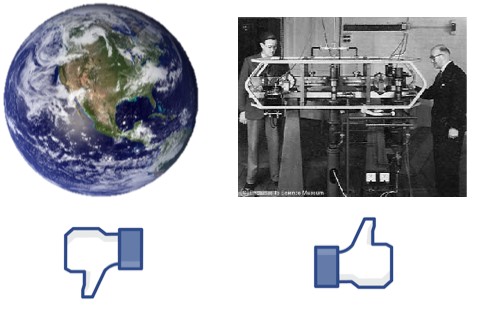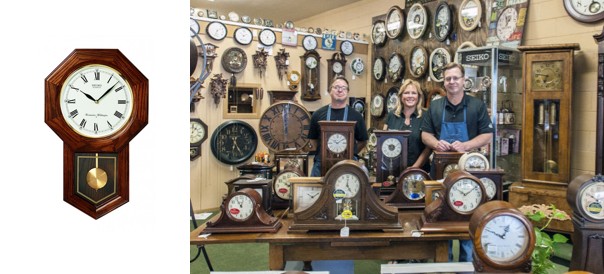Physicist: It turns out that there is no way, whatsoever, to look at a single clock and tell whether or not it’s accurate. A good clock isn’t so much accurate as it consistent. It takes two clocks to demonstrate consistency, and three or more to find a bad clock.
Just to define the term: a clock is a device that does some predictable physical process, and counts how many times that process is repeated. For a grandfather clock the process is the swinging of a pendulum, and the counting is done by the escapement. For an hour glass the process is running out of sand and being flipped over, with the counting done by hand.
A good hour glass can keep time accurate to within a few minutes a day, so sunrise and sunset won’t sneak up on you. This is more or less the accuracy of the “human clock”. Balance wheel clocks are capable of accuracies to within minutes per year, which doesn’t sound exciting, but really is.
Minutes per year is accurate enough to do a bunch of historically important stuff. For example, you can detect that the speed of light isn’t infinite. It takes 16 minutes for light to cross Earth’s orbit, and we can predict the eclipsing of Jupiter’s moons to within less than 16 minutes. In fact, telescopes, Jupiter’s moons, and big books full up look-up tables were once used to tell time (mostly on ships at sea).
Minutes per year is enough to determine longitude, which is a big deal. You can use things like the angle between the north star and the horizon to figure out your latitude (north/south measure), but since the Earth spins there’s no way to know your longitude (east/west measure) without first knowing what time it is. Alternatively, if you know your longitude and can see the Sun in the sky, then you can determine the time. It depends on which you are trying to establish.
Trouble crops up when someone clever starts asking things like “what is a second?” or “how do we know when a clock is measuring a second?”. Turns out: if your clock is consistent enough, then you define what a second is in terms of the clock, and then suddenly your clock is both consistent and “correct”.
An atomic clock uses a quantum process. The word “quantum” comes from “quanta” which basically means the smallest unit. The advantage of an atomic clock is that it makes use of the consistency of the universe, and these quanta, to keep consistent time. Every proton has exactly the same mass, size, charge, etc. as every other proton, but no two pendulums are ever quite the same. Build an atomic clock anywhere in the universe, and it will always “tick” at the same rate as all of the other atomic clocks.
So, how do we know atomic clocks are consistent? Get a bunch of different people to build the same kind of clock several times, and then see if they agree with each other. If they all agree very closely for a very long time, then they’re really consistent. For example, if you started up a bunch of modern cesium atomic clocks just after the Big Bang, they’d all agree to within about a minute and a half today. And that’s… well that’s really consistent.
In fact, that’s a lot more consistent than the clock that is the Earth. The process the Earth repeats is spinning around, and it’s counted by anyone who bothers to wake up in the morning. It turns out that the length of the day is substantially less consistent than the groups of atomic clocks we have. Over the lifetime of the Earth, a scant few billion years, the length of the day has slowed down from around 10 hours to 24. That’s not just inconsistent, that’s basically broken (as far as being a clock is concerned).

Atomic clocks are a far more precise way of keeping track of time than the length of the day (the turning of the Earth).
So today, one second is no longer defined as “there are 86,400 seconds in one Earth-rotation”. One second is now defined as “the duration of 9,192,631,770 periods of the radiation corresponding to the transition between the two hyperfine levels of the ground state of the caesium 133 atom”, which is what most atomic clocks measure.
The best clocks today are arguably a little too good. They’re accurate enough to detect the relativistic effects of walking speed. I mean, what good is having a super-watch if carrying it around ruins its super-accuracy? Scientists use them for lots of stuff, like figuring out how fast their neutrino beams are going from place to place. But the rest of us mostly use atomic clocks for GPS, and even GPS doesn’t require that many. Unless 64 is “many”.
That all said: If you have one clock, there’s no way to tell if it’s accurate.
If you have two, either they’re both good (which is good), or one or both of them aren’t. However, there’s no way to know which is which.
With 3 or more clocks, as long as at least a few of them agree very closely, you can finally know which of your clocks are “right”, or at least working properly, and which are broken.
That philosophy is at the heart of science in general. And why “repeatable science” is so important and “anecdotal evidence” is haughtily disregarded in fancy science circles. If it can’t be shown repeatedly, it can’t be shown to be a real, consistent, working thing.








12 Responses to Q: How do we know that atomic clocks are accurate?